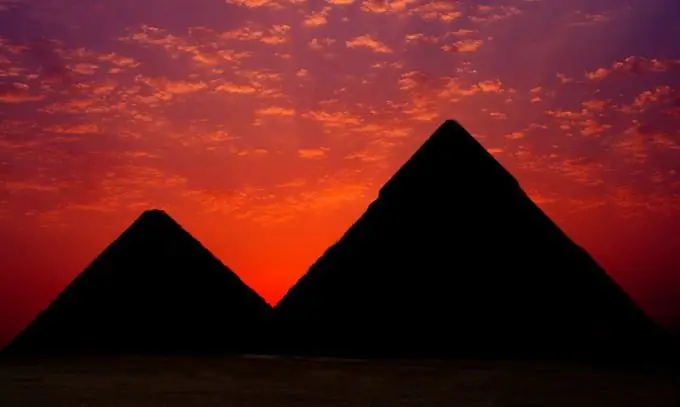A historical landscape or an account of a trip to Egypt, theatrical scenery for a scene from the life of this country - you cannot do without the image of the pyramid. In any case, you first need a sketch, which is best done on paper with a pencil, crayons or watercolors.

It is necessary
- - paper;
- - a simple pencil;
- - crayons, pencils or watercolors;
- - a picture or photograph depicting a pyramid.
Instructions
Step 1
The Egyptian pyramid is a massive structure with a large base. The base is slightly higher, so it is better to lay the sheet horizontally. For a sketch of a theatrical set, lay it in the same way as the set itself will be positioned. Determine the ratio of the base to the height. This can be done from the picture. It is not necessary to measure with a ruler, estimate it by eye.
Step 2
Draw 2 lines perpendicular to each other. Draw one parallel to the bottom edge of the sheet. Divide it in half and draw a perpendicular up to the middle. Imagine that in the picture with the image of the pyramid there are no details and texture of the material, but there are only outlines. Any pyramid will appear to be a triangle. The Egyptian pyramid is an isosceles triangle. Mark the height on the vertical line. Connect the resulting point to the ends of the base
Step 3
Determine from what point you are looking at the pyramid. The position of its lateral rib will depend on this. If the viewer stands directly in front of the edge, then he sees only a triangle made of stones. The artist can only convey the texture. Draw some thin horizontal lines. These will be layers of stone. Divide each layer into separate blocks by drawing vertical lines between adjacent horizontal ones. Lines in different layers should not be a continuation of each other
Step 4
If you decide that the viewer sees an edge of the pyramid, you need to determine the position of this edge. Draw a straight line down from the top of the structure. It will roughly halve the angle between the side of the triangle and the height. Draw it a distance just below the horizontal line. Connect the end of this new line to the vertices of the lower corners of the original triangle. Draw the lines representing the layers of masonry almost parallel to these new lines. The distance between their ends, which are closer to the viewer, is slightly larger than between the distant ends (at the edges)
Step 5
Draw the surroundings of the pyramid. This is primarily the sky and sand. All other objects next to such a gigantic structure seem small and insignificant. Use different shades of blues and blues for the sky. Make the sand an even yellowish or brownish color. If the pyramid is turned with one face towards the viewer, choose a light brown or grayish brown color for it. Circle the masonry in the same color, but thicker and darker.
Step 6
If the viewer sees the edge of the pyramid in front of him, make the edges a little lighter at their junction. Make their far edges darker. Outline the pyramid and the edge with dark paint. Draw the outlines of the masonry stones in the same color as the outlines, but with a thinner brush.






